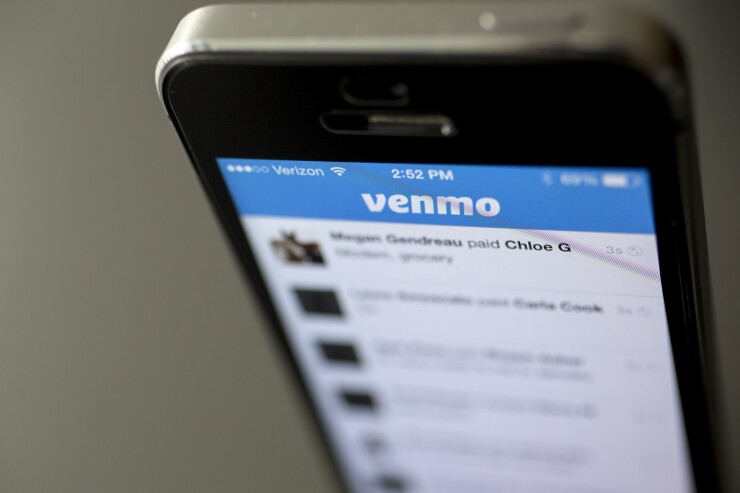Social media encompasses many new types of interactions among people that include forming opinions on how to spend and invest money, interacting with providers of services and products, and creating occasions to get together.
P-to-P payments is one type of interaction that has been embraced by millennials and fueled by smartphone use.
Yes, Bank of America, Wells Fargo and other banks have recently begun to promote partnerships with Zelle, allowing users to confidently transfer money to friends and family no matter where they bank. But this was likely done to counter Venmo, PayPal's popular payments app.
A significant share of Venmo users add emojis to accompany payments to their social network, underlining the social-media affinity of the service. Instead of using the occasion of the Zelle rollout to launch an even wider range of emojis, mobile bank customers can add no more than an old-fashioned text notification. The difference in approach is borne out by the numbers.

Venmo, which in 2013 became a member of the PayPal family, is starting to leverage its social savvy for in-store payments. The service is increasingly being accepted by merchants in the PayPal network, an incursion into the credit card issuers’ business.
E-commerce’s impact on consumer purchasing habits is a natural fit for smartphones. With a payment capability and, often, incentives for using the mobile app in-store, the lines of remote and card-present payments have become blurred. Klarna, recently expanded to the U.S. market, builds on success in European countries combining unsecured credit offerings with the e-commerce checkout process.
The offer of credit is tied to the customer’s willingness to share details about shopping cart contents as well as the context of how the purchase is being made. As this style of checkout extends beyond e-commerce to retail, credit card issuers will be pressured to innovate. They became successful with a focus on the plastic card, tied to relatively generic options of revolving credit, but are enjoying no affinity with smartphones or new types of consumer interaction.
To remain a front-and-center in the mind of the ‘mobile-powered’ consumer, they will have to overcome limitations of unsophisticated point-of-sale terminals offering little detail on purchase content. Furthermore, they need to compensate for the mobile payment card user experience defined through wallets owned by mobile phone players—and even extended to wearables such as smart watches.
Traditionally, relationships between the customer and financial service provider were supposed to be discreet and highly confidential. Yet a generation accustomed to sharing its personal data in exchange for clear benefits is well-poised to foster the growth of services like Digit.
Customers give Digit permission to harvest detailed information on income, transactions and other information from their bank accounts. Then Digit uses machine learning to analyze transaction patterns and optimize funds transferred into a Digit savings account. Banks, of course, have not emphasized expectations of trust in artificial intelligence at the forefront of customer brand perception, nor reached such a level of intimacy with customers beyond human interactions.
As lifestyles and expectations of consumers continue to change, often powered by smartphones and other technologies ever-present in their lives, banks risk weakening their leadership in the highest-valued end of their treasured customer relationships. Force-fitting traditional services only goes part of the journey and misses out on developing fundamental understanding on how the digital customer thinks and can act.





